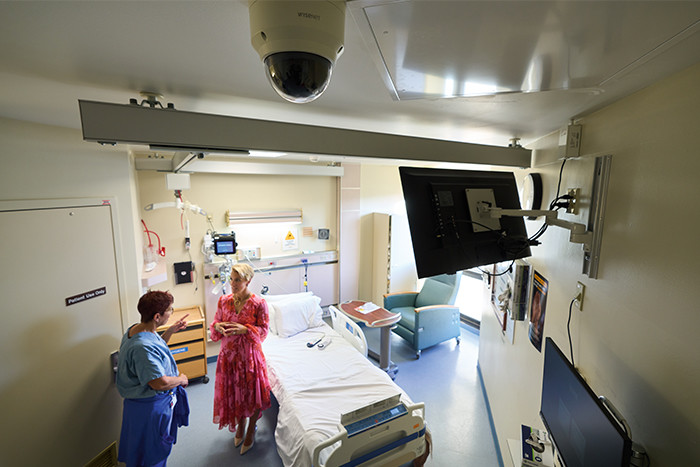When Dr. Stephanie Lahr, CIO and chief medical information officer at Monument Health in South Dakota, walked away from a pitch meeting for Artisight, she and her team instantly brainstormed two dozen ways to use the artificial intelligence solution.
“We were talking about everything from helping patients find available parking to helping them make sure they don’t lose their hearing aids and helping nurses document wound dressing changes,” Lahr says. “I’ve never been in a pitch before where literally every CIO in the room said, ‘I want that.’”
Artisight, a cornerstone of Sirius Healthcare’s Patient Room Next solutions, combines video with AI to help automate hospital workflows. Monument Health first rolled out the technology to track hand-washing and has plans to use the solution to monitor IV fluid levels and detect movements and behaviors that might lead to patient falls.
READ MORE: What is Patient Room ‘Next’ and how can healthcare organizations achieve it?
The solution is just one example of the many ways healthcare organizations are deploying technology to modernize their physical spaces and improve the patient experience.
“Room modernization is definitely a trending area, and I think we’re just scratching the surface of the technology,” says Chad Beebe, deputy executive director for the American Hospital Association’s American Society for Healthcare Engineering.
“When you go to a hospital, you want it to be technologically advanced and cutting-edge. That makes you feel comfortable. You don’t want to step back in time,” he says. “The technology infrastructure in many hospitals is probably 30 to 50 years old, and this is a great time to be updating our healthcare technology and facilities.”
Cameras and AI Create a Digital Window into Hospital Rooms
Monument Health rolled out Artisight in fall 2021. What makes the technology so exciting, Lahr says, is its potential to automate labor-intensive tasks that most human workers would rather not do, such as monitoring hand-washing. “To monitor something like that with people is very time-consuming,” she adds.
The use case also allowed Monument Health to position its Artisight cameras in highly visible spaces and begin educating staff about the technology. When people see cameras, Lahr says, they immediately think of surveillance. Artisight, however, uses the video feed for monitoring without storing footage, she adds.
“People think that a camera equals someone watching people all day long,” Lahr says. “We really want to think of this more as a digital window. It allows us to capture data without capturing video.”
At Monument Health, cameras in patient rooms give nurses more information to prioritize tasks.
With cameras in patient rooms, Lahr says, nurses will have more information to prioritize their tasks. For example, a nurse might need to change a dressing for one patient but be worried that another patient’s IV fluids will run out during that process.
“Now, they can just look,” Lahr says. “The camera can pan, tilt and zoom. You pop in with video, you angle the camera over to the IV fluids and you see that you have 45 minutes left, so you don’t have to disturb the patient. If we can chop off minutes here and there throughout the day, that turns into hours.”
One worker can monitor a dozen patients via video to make sure they’re not risking a fall from bed, she adds.
“Artisight’s algorithm allows us to understand what types of movements are more likely to result in a high-risk situation,” Lahr says. “Now, one person can monitor up to 40 patients, because the AI is curating that information and providing alerts. The AI is not replacing the per-son; it’s just allowing them to do more.”
DISCOVER: 5 ways AI and deep learning enhance patient care and hospital operations.
Patient Experience at the Center of Room Upgrades
The patient experience is one of the Guthrie Clinic’s top strategic plan priorities. The health system, operating in Pennsylvania and upstate New York, has put Apple iPad devices in patient rooms that allow them to access test results, call a nurse, order meals, view entertainment options and connect with their families via Zoom. Guthrie has also made a $5.5 million investment in new cardiac monitors as part of an effort to reduce noise in patient rooms.
“We are in the business of caring for patients, and they have a choice on where to go for care,” says CIO Terri Couts. “I can sit right here in my office at home and have a visit with a doctor at NYU or the Mayo Clinic. We want to meet our patients where they are instead of them having to meet us where we are.”
Guthrie is also making investments in cameras and speakers that will support a virtual nursing program, allowing remote nurses to virtually enter rooms for tasks that don’t require a physical presence, such as providing family members with updates or initiating the discharge process.
Some technologies impact both the patient experience and the quality of care, she says. For example, more advanced monitoring systems not only reduce room noise but also use patient-specific base-lines to reduce false alarms.
In the future, Couts says, Guthrie leaders hope to expand patients’ control over their environments, allowing them to link to personal streaming accounts or adjust the lighting from their beds.
“We have to get the management systems in place first,” Couts says. “We have older hospitals, and it takes some time to get the infrastructure in there. Too much change too quickly can actually have a negative impact.”
Healthcare Tech Implementations With a Broad Return on Investment
In Northern California, Stanford Health Care’s $2 billion, 368-bed facility, which opened in 2019, boasts an array of new technology. Patients control the lighting, temperature and window coverings in their rooms via iPad devices, which also can screencast to the 55-inch Samsung displays in each room. Radio-frequency identification tags on nurses’ badges automatically turn off call-button alarms when they walk into rooms, eliminating a task for clinicians and offering patients a quieter experience.
“From an IT perspective, it is a quantum leap,” says Gary Fritz, vice president and chief of applications at Stanford Health Care. “We rethought everything from the ground up with this hospital. The idea was to make it much easier to be a patient, and to take technology and services and literally embed them in the walls, in our workflows and throughout the natural course of the patient journey. When a patient or their family interacts with the technology, it has to be as easy as it can possibly be.”
EXPLORE: How to mitigate nurse and doctor shortages with clinical automation.
The new technology helps give patients an increased sense of agency during a vulnerable time, says Gretchen Brown, associate chief nursing informatics officer.
“The No. 1 thing patients want when they’re in the hospital is some semblance of independence,” she says. “When you’re in bed after surgery and you want the blinds closed or the temperature turned up, you don’t want to always call somebody.”











